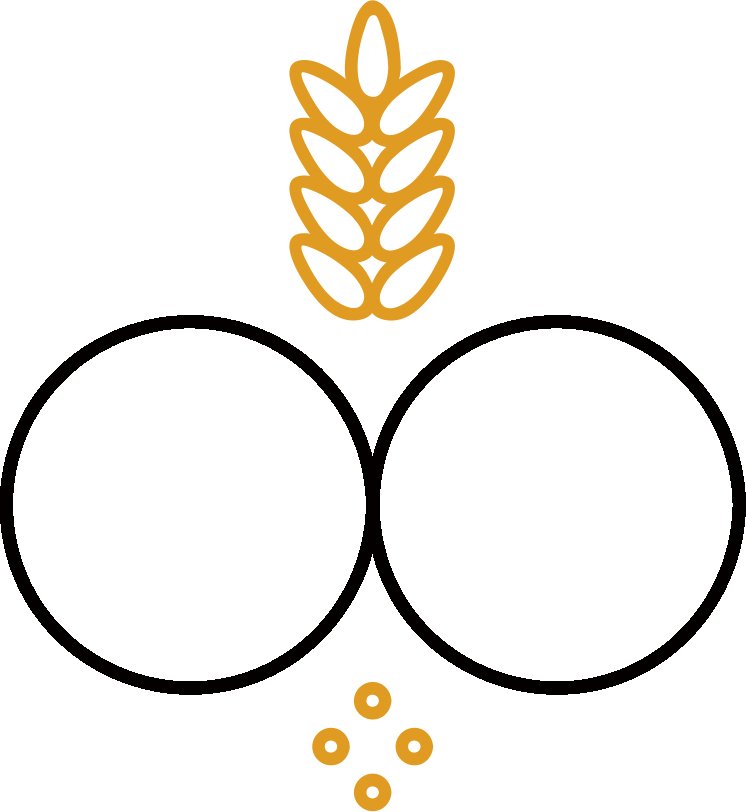First of all, 3 quick words to explain the name
BELGIUM PEAK BEER
Our brewery is located in the heart of the High Fens nature reserve at the top of Belgium. That's why the name PEAK for "summit" in English was an obvious choice for Belgium's highest brewery and for its beers.
HISTORY
The project germinated in the minds of the 2 founders in the course of 2016 and the first shovels were turned at the beginning of 2017. It was also during 2016-17 that the recipes for our first 4 beers were developed (Myrtille/Blonde/Brune/Triple). The first brew took place in October 2017. The official inauguration of the building took place in February 2018.
Ingredients
WATER
A quick explanation of why we decided to build a brewery in this unique location. It all has to do with the basic and most important ingredient in making beer: water (which makes up over 90% of the beer).
Our beers are brewed with water from the High Fens. This water is perfect for making a magnificent beer. It trickles down from the peat bogs, making the water soft (and therefore very low in minerals) and with a fairly low pH (and therefore more acidic). The result is an easily digestible beer with a particular finesse and lightness. The combination of this abundance of quality water and this magical location in the middle of the High Fens nature reserve made it the ideal place to set up our brewery.
MALT
The second ingredient is malt! Malt is barley that has been transformed in a malting plant so that the starch it contains can be converted into simple sugars during the brewing process. We have the classic blond malt, which is used for Blonde, for example. But there are also special malts used to make Brune and Winter. In total, there are 6 different malts in the composition of our Peak Brune and Winter. The more the malt has been heated or roasted, the more it colours, and therefore colours and flavours the beer. Here, there's no caramel to colour the beer, just special malts skilfully blended to achieve the right balance.
HOP
The next ingredient is hops. Hops are a very important ingredient in making beer, as they give it its bitterness and aromas. However, you only need a very small amount. You need around 100GR of hops for 100 litres of beer, whereas you need more than 15KG of malt.
There are 2 main families of hops used in brewing: bittering hops, which are mainly responsible for the beer's bitterness, and aromatic hops, which contribute mainly to the beer's aromas (which can vary from vegetal, floral, herbaceous, citrus or even tropical fruit notes, depending on the variety used). They are added at the end of the boiling stage to preserve their aromas.
YEAST
The fourth and final ingredient is yeast. Yeast is a fungus that transforms the sugars in the wort into alcohol and CO2 during fermentation. Peak brewery beers are top-fermented and are therefore fermented at a temperature of around 20°C, unlike bottom-fermented beers such as Lager, which are fermented at around 12°C.
Other ingredients, which are not compulsory, are used for Peak Blueberry (concentrated natural blueberry and blackberry juice), Peak Summer (concentrated natural mandarin juice) and Peak Winter (candy sugar). There are no added sweeteners or artificial flavourings. Peak Blueberry is a little different in that it is not sweetened like most industrial fruit beers, but is slightly acidic.
Brewing
The working day starts at 6am and finishes at the end of the day. So it's not just bakers who get up early...
In one day, we produce 3 brews of 20HL (2,000L) of beer, so 6,000L per day. That works out at around 15,000HL (1,500,000L) a year.
The process begins with the crushing of the malt. The grains are crushed so that the starch can be released from the grains in water at 50°C.
The next stage is called mashing, and involves mixing the crushed grains with the brewing water in a first vat to form a paste called mash.
The temperature is then gradually raised to 63°C and then 72°C while mixing. This transforms the starch into simple sugars (glucose, maltose, etc.). This takes about 1.5 hours.
Once this operation is complete, the mixture is transferred to a second tank for the filtration stage. This separates the solid fraction (the spent grains) from the liquid fraction (the wort, the future beer). This stage lasts about 1.5 hours.
Once filtration is complete, the wort is transferred to the third and final vat, where it is heated and boiled for 1 hour. It is during this stage that the hops are added. Boiling also sterilises the wort.
Once boiling is complete, the hops and proteins that have coagulated must precipitate to the bottom of the vat and be removed. This stage is called whirlpooling.
The wort is then cooled to 20°C and oxygenated with sterile oxygen before being transferred to the fermentation tanks.
Fermentation and ageing
We currently have 4 2,000L fermenters, 9 4,000L fermenters and 5 6,000L fermenters.
Once the must has been cooled to 20°C and transferred, the yeast is added. During alcoholic fermentation, it transforms the simple sugars into alcohol and CO2. This stage lasts 1 week.
After 1 week, the temperature is lowered to 4°C and the beer is left for a further 2 weeks. This is a cold storage stage to allow the yeast to precipitate to the bottom of the fermenter and the beer to clarify. It is also during this clarification stage that we add hops to some of our beers (Blonde/Triple/Summer/IPA). The hops will remain in contact with the beer for 4 to 5 days to allow all their aromas to diffuse into the beer. This is known as dry-hopping. The hop and yeast residues are then purged through the valve at the bottom of the vat.
After 3 weeks in the vats, the beer is still flat. The CO2 developed by fermentation has escaped through the bubblers you see alongside the fermentation tanks.
Sugar (8GR/litre of beer) must then be added before the beer is put in the bottles, so that it can undergo a second fermentation in the bottles. During this time, a small amount of alcohol will still be formed, but above all a lot of CO2, which will give the beer a magnificent sparkle and form a lovely creamy head.
Filling
We have a choice of 33cl, 75cl, 2L bottles, 20L kegs and 500L kegs (duotanks). The duotanks are connected directly to the bar.
The bottling line has a capacity of 1,500 33cl bottles per hour and 600 75cl bottles per hour. The depalletiser takes around 300 bottles at a time from the pallet and places them on the line. They are then labelled, rinsed, filled and finally capped. At the end of the line, suction cups pick up the bottles case by case, which are then automatically closed.
Refermentation in bottles
The beers are finally drawn off but are still flat. They now need to be refermented in bottles to create that fizz. This stage takes place in a warm room maintained at around 24/25°C. They will remain there for 1 to 2 weeks before being released for sale.
For the kegs, we use a different method: after 3 weeks in the tank, we dissolve CO2 directly into the beer by forced injection. It's a quicker method, because we get a lot of visitors to the bar next to the brewery, who can't wait to taste our delicious beers.














